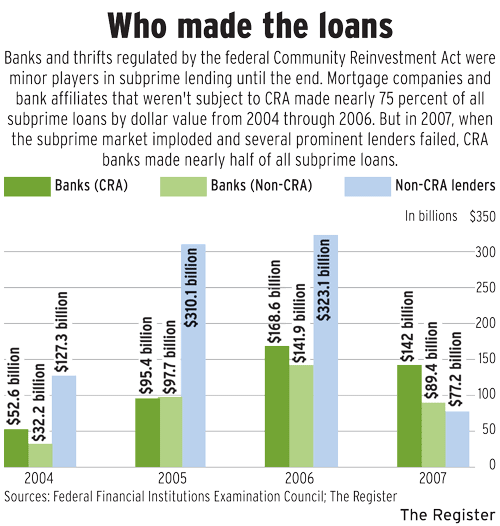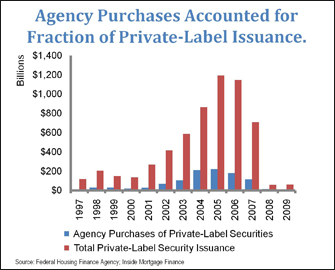(If throwing a contribution Pottersville2's way won't break your budget in these difficult financial times, I really need it, and would wholeheartedly appreciate it. Anything you can afford will make a huge difference in this blog's lifetime.)
The idea that the unemployment problem is due to lack of effort on behalf of the unemployed rather than a lack of demand is convenient for the moralists, but inconsistent with the facts. The problem is lack of demand, not the means through which we smooth the negative consequences of recessions.
But what really irks me is the implicit moralizing, the idea that people deserve to be thrown into poverty. Someone who gets up every day and goes to a job day after day, often a job they don't like very much, to support their families can suddenly become unemployed in a recession through no fault of their own. They did nothing wrong - it's not their fault the economy went into a recession and they certainly couldn't be expected to foresee a recession that experts such as Casey Mulligan missed entirely. - Mark Thoma
Robert Reich gives us pause about our elite and their glib, well-paid, fast-talking media over the Thanksgiving holiday.
Most political analysis of America’s awful economy focuses on whether it will doom President Obama’s reelection or cause Congress to turn toward one party or the other. These are important questions, but we should really be looking at the deeper problems with which whoever wins in 2012 will have to deal.
Not to depress you, but our economic troubles are likely to continue for many years — a decade or more. At the current rate of job growth (averaging 90,000 new jobs per month over the last six months), 14 million Americans will remain permanently unemployed. The consensus estimate is that at least 90,000 new jobs are needed just to keep up with the growth of the labor force. Even if we get back to a normal rate of 200,000 new jobs per month, unemployment will stay high for at least ten years. Years of high unemployment will likely result in a vicious cycle, as relatively lower spending by the middle-class further slows job growth.
This, in turn, could make political compromise even more elusive than it is now, as remarkable as that may seem. In past years, politics has been greased by the expectation of better times to come – not only more personal consumption but also upward mobility through good schools, access to college, better jobs, improved infrastructure. It’s been a virtuous cycle: When the economy grows, the wealthy more easily accept a smaller share of the gains because they still came out ahead of where they were before. And everyone more willingly pays taxes to finance public provision because they share in the overall economic gains.
Now the grease is gone. Fully two-thirds of Americans recently polled by the Wall Street Journal say they aren’t confident life for their children’s generation will be better than it’s been for them.The last time our hopes for a better life were dashed so profoundly was during the Great Depression.
But here’s what might be considered the good news. Rather than ushering in an era of political paralysis, the Great Depression of the 1930s changed American politics altogether — realigning the major parties, creating new coalitions, and yielding new solutions. Prolonged economic distress of a decade or more could have the same effect this time around.
What might the new politics look like? The nation is polarizing in three distinct ways, and any or all of could generate new political alignments.
Anti-establishment
A vast gulf separates Tea Party Republicans from the inchoate Wall Street Occupiers. The former disdain government; the latter hate Wall Street and big corporations. The Tea Party is well organized and generously financed; Occupiers are relentlessly disorganized and underfunded. And if the events of the last two weeks are any guide, Occupiers probably won’t be able to literally occupy public areas indefinitely; they’ll have to move from occupying locations to organizing around issues.
But the two overlap in an important way that provides a clue to the first characteristic of the new politics. Both movements are doggedly anti-establishment — distrusting politically powerful and privileged elites and the institutions those elites inhabit.
There’s little difference, after all, between the right’s depiction of a “chablis-drinking, Brie-eating” establishment and the left’s perception of a rich one percent who fly to the Hamptons in private jets.
In political terms, both sides are deeply suspicious of the Federal Reserve and want it to be more transparent and accountable. Both are committed to ending “corporate welfare” — special tax breaks and subsidies for specific industries or companies. And for both, Washington’s original sin was the bailing out of Wall Street.
Mere mention (of) the bailout at any Tea Party meet-in or Occupier teach-in elicits similar jeers. The first expression of Tea Party power was the Utah Tea Party’s rejection of conservative Republican senator Robert Bennett because of his vote for the bailout. At the Republican state convention, which ultimately led to the election of Senator Mike Lee, the crowd repeatedly shouted “TARP! TARP! TARP!” The Occupiers, too, began on Wall Street.
The historian Richard Hofstadter once wrote a famous essay about the recurring strain of, as he put it, a “paranoid style in American politics” — an underlying readiness among average voters to see conspiracies among powerful elites supposedly plotting against them. He noted that the paranoia arises during periods of economic stress.
But the web of interconnections linking Washington and Wall Street over the last decade or so — involving campaign contributions, revolving doors, and secret deals — has been so tight as to suggest that this newer anti-establishment activism is based on at least a kernel of truth.
Isolationist
Economic stresses caused Americans to turn inward during the Great Depression, and we’re seeing the same drift this time around. Republican fulminations against the “cult of multiculturalism” are meeting similar sentiments in traditional Democratic precincts — especially when it comes to undocumented immigrants. Alabama and Arizona have spearheaded especially vicious laws, yet polls show increasing percentages of voters across America objecting to giving the children of illegal immigrants access to state-supported services.
Meanwhile, Americans are turning against global trade. Notwithstanding new trade agreements with South Korea, Panama, and Colombia, only a minority of Americans now believes trade agreements benefit the U.S. economy. A growing percentage also want the U.S. out of the World Trade Organization. China has emerged as a special bogeyman. The Democratic-controlled Senate recently passing a bill to punish China for under-valuing its currency, but China-bashing is becoming bipartisan. Mitt Romney accuses former U.S. leaders of having “been played like a fiddle by the Chinese.”
Neither immigration, nor trade, nor China’s currency manipulation is the cause of America’s high unemployment. All three predated the crash of 2008, before which unemployment was only 5 percent. Yet the current drift toward isolationism is not entirely irrational. As hundreds of millions of workers in emerging economies — especially in Asia — continue to enter the global workforce with steadily-improving skills and higher productivity, more and more Americans are losing ground. Meanwhile, immigration and trade are boons to top executives and professionals who gain access to cheaper labor and larger markets for their own skills and insights.
Generational
A third division likely to widen if the economy remains bad runs along a demographic fault-line. Many aging boomers whose nest eggs have turned the size of humming-bird eggs are understandably anxious about their retirement, while America’s young — whose skins are more likely than those of boomer retirees to be brown or black — face years of joblessness.
The jobless rate among people under 25 is already over 17 percent. For young people of color it’s above 20 percent. For young college grads — who assumed a bachelors’ degree was a ticket to upward mobility — unemployment has reached 10 percent. Yet these percentages are likely to rise if boomers decide they can’t afford to retire, and thereby block the jobs pipeline for younger people seeking employment.
Old and young will also find themselves increasingly at odds over public spending. In many communities retirees already resist property tax hikes to pay for local schools. Expect that resistance to grow as boomers have to live on fixed incomes smaller than they expected, and a new wave of young people swarm into the nation’s educational systems. The federal budget will also be a scene of generational conflict. Medicare and Social Security, the two giant entitlement programs for seniors that cost more than $1 trillion a year and account for about a third of the federal budget, will be traded off against programs that benefit the young: Title I funding for low-income school-age students; Head Start; food stamps; child nutrition; children’s health; and vaccines. It’s likely that Medicaid — Medicare’s poor stepchild, half of whose recipients are children — will also be on the cutting board.
After the enactment of Medicare in 1965, poverty among the elderly declined markedly. But poverty among America’s children continues to rise. Yet children don’t have nearly as effective a lobbying presence in Washington. AARP spent $9.7 million on lobbying during first six months of this year, according to the Center for Responsive Politics. By contrast, the Children’s Defense Fund spent just $48,245 last year. Yet because the future lies with the young and with an increasingly diverse America, politicians and parties looking toward the longer term will have to take heed.
Solutions?
How our political parties and leaders will cope with these three fault lines is far from clear, partly because the lines don’t all move in same direction. Young Americans tend to be more anti-establishment than older Americans, for example, but are also more open to other nations and cultures. By the same token, a generational war over the budget might be avoided if anti-establishment movements succeed in reducing corporate welfare, raising taxes on the rich, and limiting Wall Street’s rapacious hold over economic decision making.
What seems certain, however, is that continued high unemployment coupled with slow or no growth will create a new political landscape. This will pose a special challenge — and opportunity. If our political leaders don’t manage the new dividing lines effectively they could invite a politics of resentment that scapegoats certain groups while avoiding the hard work of setting priorities and making difficult choices.
On the other hand, if political leaders take advantage of the energies and possibilities this new landscape offers, they could usher in an era in which the fruits of growth are more widely shared: between elites and everyone else; between the beneficiaries of globalization and those most burdened by it; and between older Americans and young. This itself could reignite a virtuous cycle — a broad-based prosperity that not only generates more demand for goods and services and therefore more jobs, but also a more inclusive and generous politics.
There is a precedent for the second alternative. The structural reforms begun in the depression decade of the 1930s generated just this kind of virtuous cycle in the three decades after World War II. And in devising and implementing these reforms, the Democratic Party came to represent Americans with little power relative to the financial and business elites that had dominated the country before the great crash of 1929. That political realignment was the most profound and successful of the twentieth century.
Will it happen again? At this point, both parties are doing remarkably little given the gravity of the continuing jobs depression and the widening gap of income and wealth. Taming the budget deficit is the only significant issue anyone in Washington seems willing to raise yet Congress seems incapable of achieving any significant progress on this. And the budget itself is only indirectly related to the deeper questions of how to restart economic growth, how much of that growth should be allocated to public goods such as the environment or education, and how the benefits of that growth are to be shared.
Political elites are worried about thunder on the right and the left, but they show scant understanding of what these growing anti-establishment forces signify. Meanwhile, the nation drifts.
The big lie? Did you miss this one over the holidays?
Settle in folks. It's a great read. Guaranteed to raise your economics IQ 20 points.
Oh, and the powers that be hope you don't.
The lies go down so much more easily then.
Examining the Big Lie: How the Facts of the Economic Crisis Stack Up
Barry Ritholtz
Washington Post, November 19, 2011
It’s fair to say that our discussion about the big lie touched a nerve.
The big lie of the financial crisis, of course, is that troubling technique used to try to change the narrative history and shift blame from the bad ideas and terrible policies that created it.
Based on the scores of comments, people are clearly interested in understanding the causes of the economic disaster.
I want to move beyond what I call “the squishy narrative” — an imprecise, sloppy way to think about the world — toward a more rigorous form of analysis. Unlike other disciplines, economics looks at actual consequences in terms of real dollars. So let’s follow the money and see what the data reveal about the causes of the collapse.
Rather than attend a college-level seminar on the complex philosophy of causation, we’ll keep it simple. To assess how blameworthy any factor is regarding the cause of a subsequent event, consider whether that element was 1) proximate 2) statistically valid 3) necessary and sufficient.
Consider the causes cited by those who’ve taken up the big lie. Take for example New York Mayor Michael Bloomberg’s statement that it was Congress that forced banks to make ill-advised loans to people who could not afford them and defaulted in large numbers. He and others claim that caused the crisis. Others have suggested these were to blame: the home mortgage interest deduction, the Community Reinvestment Act of 1977, the 1994 Housing and Urban Development memo, Fannie Mae and Freddie Mac, Rep. Barney Frank (D-Mass.) and homeownership targets set by both the Clinton and Bush administrations.
When an economy booms or busts, money gets misspent, assets rise in prices, fortunes are made. Out of all that comes a set of easy-to-discern facts.
Here are key things we know based on data. Together, they present a series of tough hurdles for the big lie proponents.
•The boom and bust was global. Proponents of the Big Lie ignore the worldwide nature of the housing boom and bust.
>
The housing boom and bust was global — Source: McKinsey Quarterly
>
A McKinsey Global Institute report noted “from 2000 through 2007, a remarkable run-up in global home prices occurred.” It is highly unlikely that a simultaneous boom and bust everywhere else in the world was caused by one set of factors (ultra-low rates, securitized AAA-rated subprime, derivatives) but had a different set of causes in the United States. Indeed, this might be the biggest obstacle to pushing the false narrative. How did U.S. regulations against redlining in inner cities also cause a boom in Spain, Ireland and Australia? How can we explain the boom occurring in countries that do not have a tax deduction for mortgage interest or government-sponsored enterprises? And why, after nearly a century of mortgage interest deduction in the United States, did it suddenly cause a crisis?
These questions show why proximity and statistical validity are so important. Let’s get more specific.The Community Reinvestment Act of 1977 is a favorite boogeyman for some, despite the numbers that so easily disprove it as a cause.It is a statistical invalid argument, as the data show.
For example, if the CRA was to blame, the housing boom would have been in CRA regions; it would have made places such as Harlem and South Philly and Compton and inner Washington the primary locales of the run up and collapse. Further, the default rates in these areas should have been worse than other regions.
>
CRA were less likely to default than Subprime Mortgages — Source: University of North Carolina at Chapel Hill
What occurred was the exact opposite: The suburbs boomed and busted and went into foreclosure in much greater numbers than inner cities. The tiny suburbs and exurbs of South Florida and California and Las Vegas and Arizona were the big boomtowns, not the low-income regions. The redlined areas the CRA address missed much of the boom; places that busted had nothing to do with the CRA.>
Suburbs and Exurbs were where the boom & bust occurred — and not the CRA regions — Source: Washington Post>
The market share of financial institutions that were subject to the CRA has steadily declined since the legislation was passed in 1977. As noted by Abromowitz & Min, CRA-regulated institutions, primarily banks and thrifts, accounted for only 28 percent of all mortgages originated in 2006.
•Nonbank mortgage underwriting exploded from 2001 to 2007, along with the private label securitization market, which eclipsed Fannie and Freddie during the boom.
Check the mortgage origination data: The vast majority of subprime mortgages — the loans at the heart of the global crisis — were underwritten by unregulated private firms. These were lenders who sold the bulk of their mortgages to Wall Street, not to Fannie or Freddie. Indeed, these firms had no deposits, so they were not under the jurisdiction of the Federal Deposit Insurance Corp or the Office of Thrift Supervision. The relative market share of Fannie Mae and Freddie Mac dropped from a high of 57 percent of all new mortgage originations in 2003, down to 37 percent as the bubble was developing in 2005-06.
>
Nonbank mortgage underwriting exploded from 2001 to 2007, along with the private label securitization market, which eclipsed Fannie and Freddie during the boom – Source: University of North Carolina at Chapel Hill
>
•Private lenders not subject to congressional regulations collapsed lending standards. Taking up that extra share were nonbanks selling mortgages elsewhere, not to the GSEs. Conforming mortgages had rules that were less profitable than the newfangled loans. Private securitizers — competitors of Fannie and Freddie — grew from 10 percent of the market in 2002 to nearly 40 percent in 2006. As a percentage of all mortgage-backed securities, private securitization grew from 23 percent in 2003 to 56 percent in 2006
>Subprime Lenders were (Primarily) Private
Only one of the top 25 subprime lenders in 2006 was directly subject to the housing laws overseen by either Fannie Mae, Freddie Mac or the Community Reinvestment Act — Source: McClatchy>
These firms had business models that could be called “Lend-in-order-to-sell-to-Wall-Street-securitizers.” They offered all manner of nontraditional mortgages — the 2/28 adjustable rate mortgages, piggy-back loans, negative amortization loans. These defaulted in huge numbers, far more than the regulated mortgage writers did.
Consider a study by McClatchy: It found that more than 84 percent of the subprime mortgages in 2006 were issued by private lending. These private firms made nearly 83 percent of the subprime loans to low- and moderate-income borrowers that year. And McClatchy found that out of the top 25 subprime lenders in 2006, only one was subject to the usual mortgage laws and regulations.
A 2008 analysis found that the nonbank underwriters made more than 12 million subprime mortgages with a value of nearly $2 trillion. The lenders who made these were exempt from federal regulations.
>
Lenders made 12 million subprime mortgages with a value of nearly $2 trillion. Mortgage Companies and Thrifts NOT affiliated with CRA made 75% of Subprime Loans from 2004-07, Source: Orange County Register>
A study by the Federal Reserve shows that more than 84 percent of the subprime mortgages in 2006 were issued by private lending institutions. The study found that the government-sponsored enterprises were concerned with the loss of market share to these private lenders — Fannie and Freddie were chasing profits, not trying to meet low-income lending goals.
Fannie and Freddie risky loan purchases was dwarfed by Private Label Securitization Source: University of North Carolina at Chapel Hill>
Beyond the overwhelming data that private lenders made the bulk of the subprime loans to low-income borrowers, we still have the proximate cause issue. If we cannot blame housing policies from the 1930s or mortgage tax deductibility from even before that, then what else can we blame? Mass consumerism? Incessant advertising? The post-World War II suburban automobile culture? MTV’s “Cribs”? Just how attenuated must a factor be before fair-minded people are willing to eliminate it as a prime cause?
I recognize all of the above as merely background noise, the wallpaper of our culture. To blame the housing collapse that began in 2006, a recession dated to December 2007 and a market collapse in 2008-09 on policies of the early 20th century is to blame everything — and nothing.
~~~
Ritholtz is chief executive of FusionIQ, a quantitative research firm. He is the author of Bailout Nation and runs a finance blog, The Big Picture.







































2 comments:
Reich you poor boy. "Solutions" from the likes of these guys and gals in DC. He has to be smarter than that.
"How our political parties and leaders will cope with these three fault lines is far from clear, partly because the lines don’t all move in same direction."
Hi Suzan happy belated bird day. Hope you're doing well. T.
Thanks, Tom!
Bob is just wringing his hands now in all his columns.
Everybody knows that bad things are in store and that there is nothing Obama can or will do to avert it.
Seems we're all getting used to the lesser of two evils.
As if.
Love ya,
S
Post a Comment